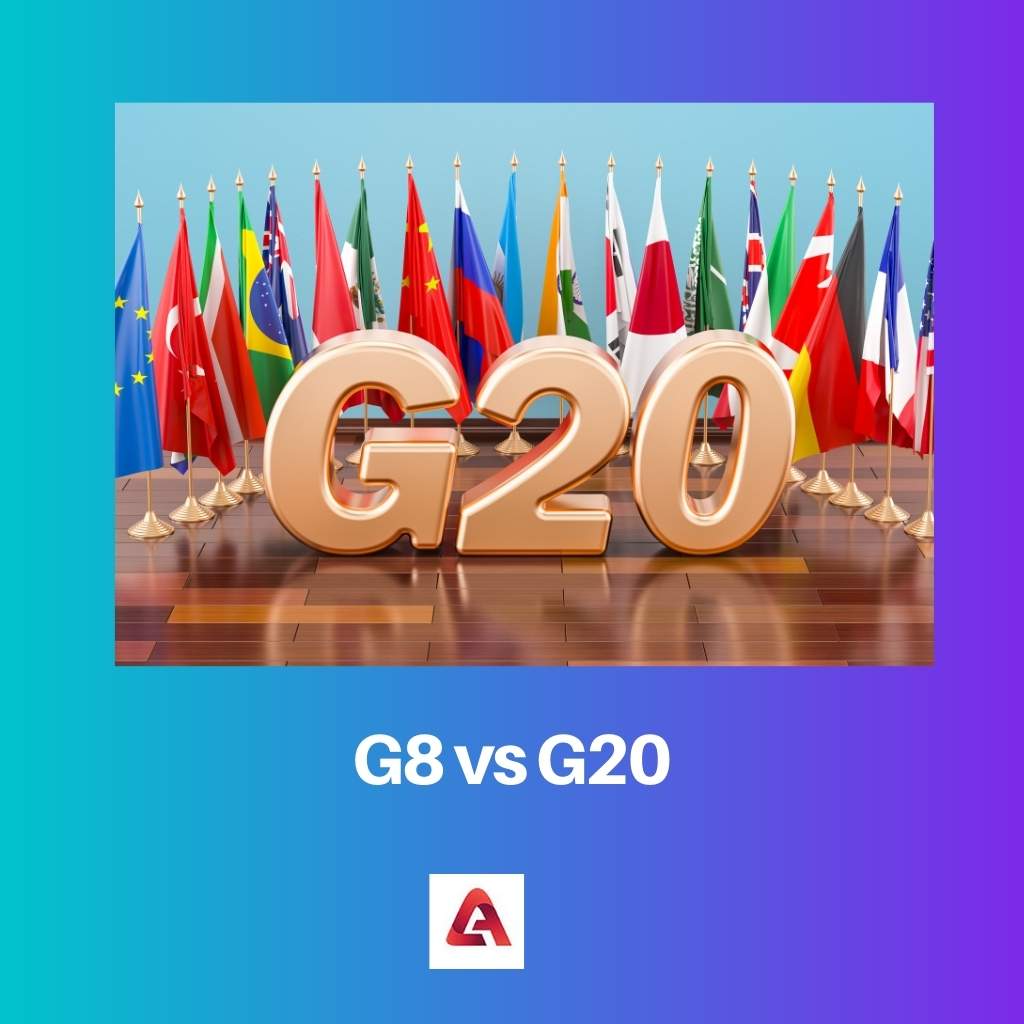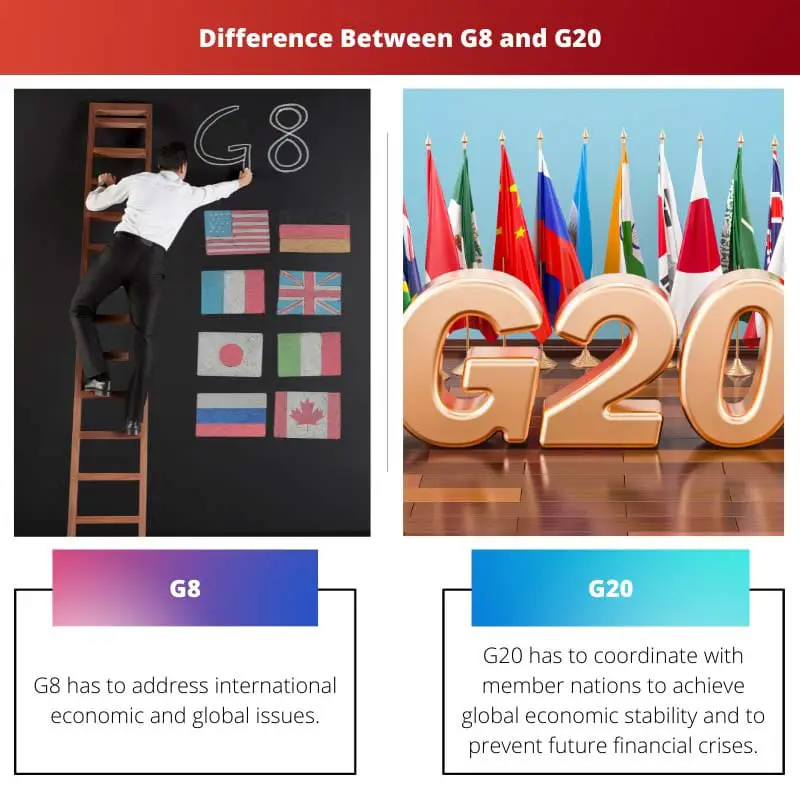The world is evolving and becoming a global village. The political and financial condition of one region affects the other region. The oil crises and the collapse of Bretton Woods fixed exchange rates had the entire world at a threshold.
These crucial economic crises in the 1970s prompted the developed countries to form a group to discuss international economic policies
The aim of these groups is industrial stability and sustainable growth. The G8 comprises industrialized and developed countries. The G20 is composed of the developing economies of the world.
Key Takeaways
- G8 consists of eight major industrialized nations, while G20 includes 19 countries and the European Union, representing a larger share of the global economy.
- G8 focuses on economic issues and international security, while G20 addresses broader financial and economic policies.
- G20 has a more inclusive membership, encompassing emerging economies, whereas G8 is limited to wealthy, developed countries.
G8 vs G20
G8 is an organization of eight great countries that are economically developed and was founded in 1975. It includes France, Italy, Germany, the US, the UK, Russia, Japan and Canada. G20 is an informal body of great countries consisting of 19 countries and the European Union, with representatives of the IMF and World Bank.

G8 came into existence in the year 1975. It includes economically developed countries like France, Germany, Italy, and Japan. UK and the US-allied(G6). In 1976, Canada joined the alliance(G6), and in 1997, Russia formally created the G8.
The crucial point of discussion in the schedule is the financial and economic concerns. Ministers of the member countries get together frequently to discuss matters of mutual interest.
The G20 is an informal body consisting of 19 nations and the European Union, which comprise the G20. The G20 embodies representatives of the International Monetary Fund(IMF) and the World Bank.
The finance ministers of representative countries hold discussions on issues of global importance. The G20 plays a pivotal role as the member countries make up 80% of the world trade.
Comparison Table
| Parameters of Comparison | G8 | G20 |
|---|---|---|
| Purpose | G8 has to address international economic and global issues. | G20 has to coordinate with member nations to achieve global economic stability and to prevent future financial crises. |
| Members | G8 consists of economically powerful nations. | G20 consists of major growing economies of the world |
| Date of establishment | The first summit was held in the year 1975 in Paris. | G20 was established in 1999. |
| Number of members | G8 comprises eight-member nations. | G20 comprises 20 member nations. |
| Nature of Members | Finance ministers and bank governors are part of G8. | High-rank ministers, foreign ministers, and leaders of government are part of the G20. |
What is G8?
The enormous worldwide money troubles in the early 1970s prompted the Finance Ministers of Britain, France, Germany, and the US to form a library group in 1973.
The group name was after the initial meeting in the White House Library. The G6 consisted of France, Germany, Italy, Japan, the UK, and America.
It interchanged with G7 in 1976 when Canada joined and unified G7. Later on, in 1998, Russia followed along, and G8 was established.
The G7, established in 1976, was ground enough for the heads of state and government to consult on international economic policy. The first summit was in 1975 – formally known as the G6.
The presidentship of the G8 rotates yearly. The nation conducting the presidentship is in charge of holding and arranging the yearly summit.
The summit is an opportunity for the leaders to have an open discussion of crucial global issues. Before the summit, the ambassador’s secretaries provide the groundwork for discussion and the follow-up meeting.
The G8 forum provides an opportunity to discuss global challenges. The standards coordinated and commitments taken ensure prosperity and economic growth globally; since the 1990s, the summit has garnered intense media attention and demonstrations.

What is G20?
The G20 comprises a mixture of sizable, emerging, and advanced economies. These countries amount to 2/3rd of the world’s population and account for 80% of the global trade. The G20 consists of 19 nations and the EU.
The Group of Seven founded G20, and it was established on 26th September 1999.
The associates of the G20 are Argentina, Saudi Arabia, South Africa, Australia, Canada, Russia, the UK, EU, USA, Turkey, India, Brazil, France, Mexico, Korea, Italy, Germany, China, Japan, and Indonesia.
The president of G20 invites several non-members to participate and contribute to the G20 agenda. It ensures a broader international global perspective.
The work of G20, supported by several international organizations, provides advice to policymakers. The G20 Presidency rotates annually to ensure regional balance. Since it is a nonformal forum, the appointment of a permanent secretariat is not considered essential.
The presidency takes the responsibility to consolidate the G20 schedule in consultation with the members and the global requirements. To ensure continuity of presidency, ‘Troika’ is supported.
It comprises the current, immediate past, and the upcoming hosting country. During the Turkey summit, the members of the Troika were Turkey, Australia, and China.

Main Differences Between G8 and G20
- The G8 consists of economically powerful nations. The G20 consists of the growing economies of the world.
- The G8 members comprise eight countries. The G20 consists of 19 countries and European Nations.
- The G8 was established in the year 1975. The G20 was established in 1997.
- The G8 members consist of industrialized, developed nations. The G20 is an informal group consisting of the G8 members and the other 12 countries.
- The G8 group consists of finance ministers and bank governors. The G20 group consists of high-rank ministers, foreign ministers, and leaders of government.

- https://onlinelibrary.wiley.com/doi/abs/10.1111/j.1758-5899.2011.00121.x
- https://www.cigionline.org/sites/default/files/g20no6-2.pdf

This article was very informative and insightful. I learned a lot about the G8 and G20 and their differences, thank you!
This article does an excellent job at comparing the G8 and G20, providing a comprehensive understanding of the two organizations. A significant contribution to discussions on global economics.
I totally agree. Discussions covering international economics are essential, and this article delivers the information effectively.
This article emphasizes the significance of G8 and G20 and offers a remarkable depth of knowledge. Kudos to the author for delivering such detailed and informative content.
This article provides a thorough analysis of the history, purpose, and key differences between G8 and G20. A must-read for anyone interested in global economics.
Absolutely. The depth of information presented here is impressive and thought-provoking.
The detailed comparison of G8 and G20 is beyond what I expected. Precise, insightful, and comprehensive – a superb piece of work.
Absolutely. It’s clear that the research and effort put into this article have resulted in a high-quality and valuable resource for those interested in global economics.
The in-depth analysis of G8 and G20 is truly impressive. This article provides a vital understanding of these organizations and their impact on global economics.
The explanation of G8 and G20 was excellent. I appreciate how it goes into detail about their purposes, members, and nature. Well done!
Quite an engaging read, had a blast going through it! It highlights the importance of both G8 and G20 and the fundamental differences between the two.
Agreed, this article offers an enjoyable yet in-depth look at the G8 and G20. A commendable piece of work.
Indeed, learning about global economics doesn’t get better than this. A well-crafted article that captures the readers’ attention.